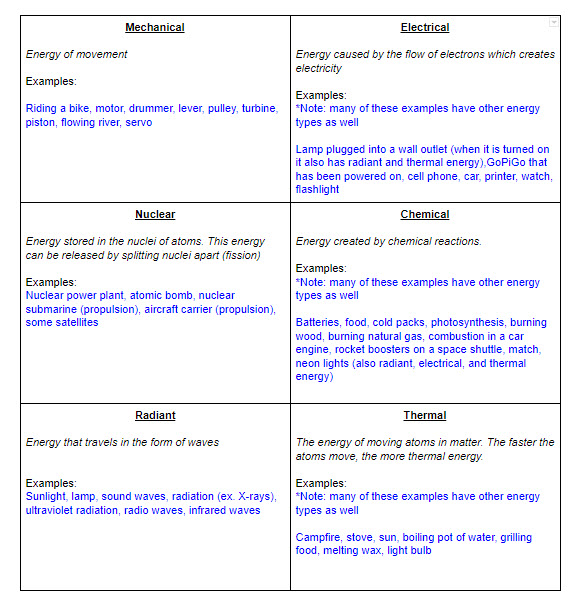Lesson 2: Energy Transformations - Forms of Energy
The students will identify and describe the six basic forms of energy. The students will describe how energy is transformed from one form to another.
Setup
- Copy student handouts
Attachments:
Introduction
- Show the first 20 seconds of the “Optimus Prime - Prime and Ready” video clip - http://transformers.hasbro.com/en-us/videos to the students. Ask the class, what does it mean to transform?
- Ask the students what they already know about energy transformations. If needed, prompt the students to discuss the previous lesson about the Law of Conservation of Energy, kinetic energy, and potential energy.
Procedure
- Tell the class, “There are six basic forms of energy - mechanical, chemical, electrical, nuclear, radiant, and thermal.”
- Define and explain each type of energy. Project the chart on the board or create an anchor chart with the information. Ask the students to give examples of each type of energy to complete the chart. Some examples are shown in the chart below.
- Ask the students, “What is the Law of Conservation of Energy?” Discuss how energy is neither created nor destroyed. It changes from one form to another.
- Ask the students to think about the different energy transformations that occur when a computer is turned on. Give the students 1-2 minutes to jot down their thoughts. Discus possible sequences of energy transformations as a class. Chemical (if using the battery) → Electrical → Radiant → Thermal
- Repeat this process for the other examples. Depending on the individual student needs, students may work as pairs to brainstorm the energy transformation sequences before the whole class discussion.
- Tell the class that they are now going to think about how flows and is transformed through the GoPiGo robots. Scenario - Dr. Dex just finished his Shrink Ray and you are his first test subject! You are now the size of an electron and have been injected into one of the batteries on your GoPiGo robot. Write a story to describe your journey through the robot. Describe all of the energy transformations that go on as your robot is turned on, programmed, run, and shut down.
- Students will work individually or in pairs to determine the energy flow through the GoPiGo and write a story to tell about their journey through the GoPiGo to describe the energy transformations that occur. (45 minutes - 1 hour).
- If time, students may share their flow charts and/or their stories with the class.


Closure
- Ask the students to describe how this lesson is relevant to their life and/or how they may use the concepts they learned it in the future.
Last modified: Wednesday, 11 November 2020, 9:28 AM